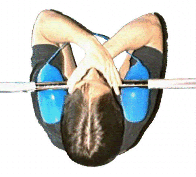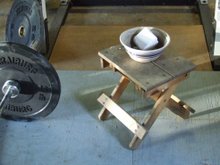 Don't do front squats? You're in the unfortunate majority. Most people don't do this basic, quad-blasting, multi-joint exercise because it's awkward and it hurts. Nevermind the muscle pain; this move hurts from the crush of the bar onto the shoulders and collarbone. The tissue hurts from the pressure, and the pressure passed on through the ribcage can make it difficult to breathe. So no wonder most people try this one out and then forget about it.
Don't do front squats? You're in the unfortunate majority. Most people don't do this basic, quad-blasting, multi-joint exercise because it's awkward and it hurts. Nevermind the muscle pain; this move hurts from the crush of the bar onto the shoulders and collarbone. The tissue hurts from the pressure, and the pressure passed on through the ribcage can make it difficult to breathe. So no wonder most people try this one out and then forget about it.
It's too bad, because front squats are a great way to activate the quad groups. Mark Pittroff, president of Advanced Fitness, tells me, "You sit so upright in front squats that you use hardly any glute, hip, low back, so the load comes much more from the frontal quad. Years ago Arthur Jones (inventor of Nautilus machines) used sophisticated equipment to test a world-record squatter and found his quads were doing hardly any of the lift. Just the opposite of front squats."
Front squats are a basic exercise of Olympic-style weightlifting, but we hold the bar in a "racked" position instead of the way that this device is designed for. And that's good for the general public, because unless you're training for weightlifting, you probably will use this position. This is great for anyone with flexibility issues.
So whatever your goals, now you can add the front squat to your list of staple exercises, thanks to the Sting Ray. Mark, who brought us the legendary Manta Ray, has once again given the world an indispensable accessory for leg day. (It's been out for a while, but I finally got to try one, thanks to Mark.)
Before I launch into the glowing accolades, there are a couple of things to keep in mind. If you don't normally do front squats, this will feel awkward at first. Be sure to follow the directions carefully, especially getting the bar as close to your body as possible. Load the bar lightly--try about 6x less your regular squat load (there will always be dramatic disparity between the two squat loads). Trying to keep the shoulders raised to 45 degrees is tough, and by nature, it means your anterior deltoids are contracted and bearing the load of the bar throughout the exercise. This is a good one to bring in a spotter for, not only to save you from spills, but to help prop the elbows when the delts fatigue (because you'll keep going, but the arms will drop, and the biomechanics will change). This device doesn't really lend itself to the Olympic lifting grip, so as it emphatically states, follow the directions (see photo for hand position). And by the way, try this on a Smith machine as well as the free bar.
Okay, now to give the Sting Ray its props. From the biomechanical logic to the durable design to the thoughtful practicality of connecting the two components so they don't get separated (like mittens), Mark has once more proven himself as an important inventor in the gym.
I usually write my own thoughts on products, but in this case, the marketing copy from Advanced Fitness really nails it. So, from the company, all backed up by the Mighty Kat, below are the specific benefits of the Sting Ray.
- Lifts the bar off the collar bone allowing full expansion of the rib cage
- Provides easy bar control without stressing shoulder, elbow, or wrists
- Allows the widest rack on the body by moving the load out to the front delt
- Keeps the Humerus in a safe neutral position
- Protects the lifters body so all new repair tissue goes where you want it
- Small and lightweight yet virtually indestructible for years of tough service
The Sting Ray (like the Manta Ray) is made of a high-tech polyurethane polymer. This material is flexible enough in the upward projecting bosses to snap on and off the bar indefinitely, but rigid enough in the thicker sections to act as a load distributor. With the surface area of the bar increased as much as 1600%, the biggest problem with transferring weight to the human body is eliminated.
One last perk -- the rays are made in the U.S.A., in Cincinnati, Ohio.
(About $40 (or combine it with the Manta ray for $75 altogether))
Get it at Advanced Fitness




No comments:
Post a Comment